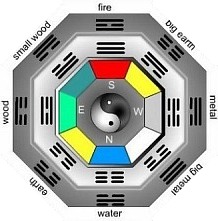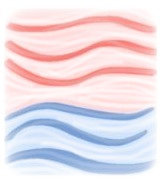Welcome
|
|
|
This site explains Taoist Classical Feng Shui in
(hopefully) clear, concise, jargon free English. It covers the
basic theory, insight into more advanced
metaphysics and includes practical design
suggestions.
Please use it as a resource to discover and implement change.
It is best to read the
main sections in sequence:
The
sub-sections
give additional information.
|
Qi
Yin
& Yang
5 Elements
8
Directions
|
:: The energies involved, how they effect us.
:: Duality of the physical, the two primary forces.
:: The main types of energy, their origin and qualities.
:: Energy types by direction, their qualities and portents.
|
|
 |
|
 |
Introduction
|
|
|
Geomancy is the art of reading energetic interactions
that occur here on Earth and how they affect us.
Most ancient cultures (Aboriginal, African, American
Indian, Celtic, Chinese, Egyptian, Indian, Nordic, Mayan
etc.) have their own systems of explanation.
Feng Shui, the Chinese Taoist form of Geomancy, provides
one of the most comprehensive and well documented explanations.
|
 |
Feng
Shui - general
|
|
|
The Taoists explained energetic interactions with a
system derived from their knowledge of creation. The
theory underlying Feng Shui is the same for all Taoist
practices including the Martial arts (Tai Qi Chuan, Qi Gong, etc.),
Medicine (Acupuncture, Herbal remedies etc.) and Internal Alchemy.
The concept of Qi (energy) its creation, varied
qualities and interactions is key.
There are a number of different Schools
(approaches) of Feng Shui (Form School, Compass School, Black
Sect School, Flying Star School & Classical School). The
Classical School is an amalgam of traditional theories and this is
explained here.
|

8 directions (bagua)
|
Feng
Shui - definition
|
|
|
Feng
is Qi (energy) that flows above the ground and
occupies every space there is, it flows as wind, and is fast moving.
It's characteristics are dependent upon the direction in which it flows
and the environment it occupies. It can be partially described as
electromagnetically charged particles in the atmosphere.
Shui
is Qi (energy) that is contained within the earth and is inherent in
the structure of a building (all mass), it is slow moving. Shui can be
experienced as a cool blue energy, hence being called water, it is
essentially gravitational force.
The practice of Feng Shui aims to balance these energies
to benefit the occupant/s. It is a system of assessing the quality of
energies at play and calculating how they interact.
|

wind
- Feng (Yang ) above
&
water - Shui ( Yin ) below.
|
Feng
Shui - application
|
|
|
A magnetic compass (Lo Pan) is used to determine
site/space orientation, the relevant energies at play and how
they interact. Qi (energy) has different characteristics dependant upon
direction.
( please refer to
the 8
Directions
section of this site for details).
Assessment
is based on orientation,
a personal reading and other
general observations which are outlined below.
|

Lo
Pan - Compass
|
Feng Shui -
assessment
An assessment of the site begins
outside and works
inwards.
Consider the macro (large)
environment first and work your way down to the micro (small).
|
|
|
1. Environment (macro)
|
Larger site topography
(mountain ranges, plains etc)
|
|
|
2. Immediate
environment
|
Surrounding
landscape/buildings, main local features (adjacent buildings, trees,
watercourses, roads etc).
|
|
|
3. Site
|
The form (shape) of your
property and its position in the landscape.
|
|
|
4. Orientation
|
N,NE,E,SE,S,SW,W,NW (magnetic
compass reading to assess the main energies involved).
|
|
|
5. Internal
|
Main internal flows/speed and
exchanges of energy.
|
|
|
6. Structure
|
Structural elements, location,
whether exposed or not and materials used.
|
|
|
7. Individual spaces
|
Portents derived from compass
readings using the Bagua's (eight directions).
|
|
|
8. Micro-directions
|
To within 2 degrees. (more
specific calculations).Advanced - Used in the calculation of Water
Dragon and very specific placement.
|
|
|
9. Personal reading
|
Calculation of personal
number. To determine which directions are most suitable.
|
|
|
|
NB: Always deal with the macro
first - there is no point worrying about the placement of a picture
when you have a motorway attacking the front of your house.
|
|
Feng Shui - key
aims
-
To determine the best site/building for
individuals.To balance the property to suit the occupants,
maximizing potential.
-
Ensure an ample supply of good Qi into the
property/space and a natural flow throughout.Counteract malign
influences.
-
Orientate / position furniture, objects, working,
living, sleeping areas favourably (using portents derived
from Baguas).
-
Using colour to manipulate the energy of
rooms/spaces
favourably, (using the 5 element cycle).
-
Changing locations and
orientation of doors / windows
to affect the main energy and its exchange of a
building / space.
|
|
Mythology
All ancient traditions use metaphors and myth in
explanation.
An over emphasis on 'taking things literally' can lead
to misinterpretation.
Myth and symbology are an excellent way of condensing a
large amount of information into a usable form. After all, the point of
knowledge is to integrate it into your being.
An example:
The Green Dragon
is a great
mythological figure in traditional Chinese culture and is
the symbol of the Emperor.
The Green Dragon
is the symbol of
fertility and male vigour and also represents the East, the Wood
element and the eastern side of a building.
The Green Dragon
has the same
attributes as the element Wood. (please refer to the 5 element
section of this site).
The Green Dragon
is the source of
rain, water is his life blood and he breathes fire
(Water feeds Wood (the dragon) and creates Fire). This interaction
relates to what is known as 'The Eastern Life' or the directions and
elements on the Eastern Generative Cycle (water, wood, small wood and
fire - N,E,SE,S). The 'Western Life' directions are NE,SW,W &
NW and this is symbolised by the White Tiger. You may have heard of the
Dragon and Tiger (left and right) side of a building and Dragon and
Tiger shaped hill formations.
|

|
|
Footnote:
Everything is connected, the planets, the elements and
all the living things.
What we experience externally reflects our internal
universe. Hence our environment is a reflection of ourselves and vice
versa. Balancing the external environment has a direct effect upon our
internal condition and helps us to realize our potential.
|
|
|
| Introduction
Qi
(energy) Yin
& Yang 5
Elements 8
Directions |
top
of page |






